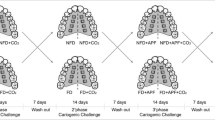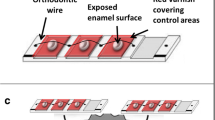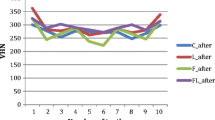Abstract
Objectives
The caries-protective effects of CO2 laser irradiation on dental enamel have been demonstrated using chemical demineralization models. We compared the effect of CO2 laser irradiation, sodium fluoride, or both on biofilm-induced mineral loss (∆Z) and Streptococcus mutans adhesion to enamel and dentin in vitro.
Materials and methods
Ground, polished bovine enamel, and dentin samples were allocated to four groups (n = 12/group): no treatment (C); single 22,600-ppm fluoride (F) varnish (5 % NaF) application; single CO2 laser treatment (L) with short pulses (5 μs/λ = 10.6 μm); and laser and subsequent fluoride treatment (LF). Samples were sterilized and submitted to an automated mono-species S. mutans biofilm model. Brain heart infusion plus 5 % sucrose medium was provided eight times daily, followed by rinses with artificial saliva. After 10 days, bacterial numbers in biofilms were enumerated as colony-forming units/ml (CFU/ml) (n = 7/group). ∆Z was assessed using transversal microradiography (n = 12/group). Univariate ANOVA with post hoc Tukey honestly-significant-difference test was used for statistical analysis.
Results
Bacterial numbers were significantly higher on dentin than enamel (p < 0.01/ANOVA). On dentin, LF yielded significantly lower CFUs than other groups (p = 0.03/Tukey), while no differences between groups were found for enamel. The lowest ∆Z in enamel was observed for L (mean/SD 2036/1353 vol%×μm), which was not only significantly lower than C (9642/2452 vol%×μm) and F (7713/1489 vol%×μm) (p < 0.05) but also not significantly different from LF (3135/2628 vol%×μm) (p > 0.05). In dentin, only LF (163/227) significantly reduced ∆Z (p < 0.05).
Conclusion/clinical relevance
CO2 laser irradiation did not increase adhesion of S. mutans in vitro. Laser treatment alone protected enamel against biofilm-induced demineralization, while a combined laser-fluoride application was required to protect dentin.


Similar content being viewed by others
References
Tellez M, Gomez J, Kaur S, Pretty IA, Ellwood R, Ismail AI (2012) Non-surgical management methods of noncavitated carious lesions. Community Dent Oral Epidemiol 41:79–96. doi:10.1111/cdoe.12028
Tenuta LM, Cury JA (2013) Laboratory and human studies to estimate anticaries efficacy of fluoride toothpastes. Monogr Oral Sci 23:108–124. doi:10.1159/000350479
Fox JL, Yu D, Otsuka M, Higuchi WI, Wong J, Powell G (1992) Combined effects of laser irradiation and chemical inhibitors on the dissolution of dental enamel. Caries Res 26:333–339
Fried D, Seka W, Glena RE, Featherstone JDB (1996) Thermal response of hard dental tissues to 9- through 11-μm CO2-laser irradiation. Opt Eng 35:1976–1984
Featherstone JDB, Barrett-Vespone NA, Fried D, Kantorowitz Z, Seka W (1998) CO2 laser inhibition of artificial caries-like lesion progression in dental enamel. J Dent Res 77:1397–1403
McCormack SM, Fried D, Featherstone JDB, Glena RE, Seka W (1995) Scanning electron microscope observations of CO2 laser effects on dental enamel. J Dent Res 74:1702–1708
Fried D, Murray MW, Featherstone JDB, Akrivou M, Dickenson KM, Duhn C and Ojeda OP (1999) Dental hard tissue modification and removal using sealed TEA lasers operating at λ = 9.6 μm and 10.6 μm. Book title. Bellingham, San Jose
Gerard DE, Fried D, Featherstone JD, Nancollas GH (2005) Influence of laser irradiation on the constant composition kinetics of enamel dissolution. Caries Res 39:387–392
Rechmann P, Fried D, Le CQ, Nelson G, Rapozo-Hilo M, Rechmann BM, Featherstone JD (2011) Caries inhibition in vital teeth using 9.6-mum CO2-laser irradiation. J Biomed Opt 16:071405. doi:10.1117/1.3564908
Esteves-Oliveira M, Zezell DM, Meister J, Franzen R, Stanzel S, Lampert F, Eduardo CP and Apel C (2009) CO2 Laser (10.6 μm) parameters for caries prevention in dental enamel. Caries Res 43:261–8. doi: 000217858
Esteves-Oliveira M, Pasaporti C, Heussen N, Eduardo CP, Lampert F, Apel C (2011) Prevention of toothbrushing abrasion of acid-softened enamel by CO2 laser irradiation. J Dent 39:604–611
Esteves-Oliveira M, Witulski N, Hilgers R-D, Apel C, Meyer-Lückel H, Eduardo CP (2015) Combined tin-containing fluoride solution and CO2 laser treatment reduces enamel erosion in vitro. Caries Res 49:565–574. doi:10.1159/000439316
Esteves-Oliveira M, Pasaporti C, Heussen N, Eduardo CP, Lampert F, Apel C (2011) Rehardening of acid-softened enamel and prevention of enamel softening through CO2 laser irradiation. J Dent 39:414–421
Hu XL, Ho B, Lim CT, Hsu CS (2011) Thermal treatments modulate bacterial adhesion to dental enamel. J Dent Res 90:1451–1456. doi:10.1177/0022034511424155
Song F, Koo H, Ren D (2015) Effects of material properties on bacterial adhesion and biofilm formation. J Dent Res 94:1027–1034. doi:10.1177/0022034515587690
Cohen J, Featherstone JD, Le CQ, Steinberg D, Feuerstein O (2014) Effects of CO2 laser irradiation on tooth enamel coated with biofilm. Lasers Surg Med 46:216–223. doi:10.1002/lsm.22218
Dibdin GH, Shellis RP, Wilson CM (1976) An apparatus for the continuous culture of micro-organisms on solid surfaces with special reference to dental plaque. J Appl Microbiol 40:261–268
Sissons CH, Cutress TW, Hoffman MP, Wakefield JSJ (1991) A multi-station dental plaque microcosm (artificial mouth) for the study of plaque growth, metabolism, pH, and mineralization. J Dent Res 70:1409–1416
Schwendicke F, Dorfer C, Kneist S, Meyer-Lueckel H, Paris S (2014) Cariogenic effects of probiotic lactobacillus rhamnosus GG in a dental biofilm model. Caries Res 48:186–192. doi:10.1159/000355907
Bratthall D, Hansel Petersson G (2005) Cariogram—a multifactorial risk assessment model for a multifactorial disease. Community Dent Oral Epidemiol 33:256–264. doi:10.1111/j.1600-0528.2005.00233.x
Wong L, Sissons CH (2001) A comparison of human dental plaque microcosm biofilms grown in an undefined medium and a chemically defined artificial saliva. Arch Oral Biol 46:477–486. doi:10.1016/s0003-9969(01)00016-4
Schwendicke F, Horb K, Kneist S, Dorfer C, Paris S (2014) Effects of heat-inactivated Bifidobacterium BB12 on cariogenicity of Streptococcus mutans in vitro. Arch Oral Biol 59:1384–1390. doi:10.1016/j.archoralbio.2014.08.012
Marinho VC, Worthington HV, Walsh T, Clarkson JE (2013) Fluoride varnishes for preventing dental caries in children and adolescents. Cochrane Database Syst Rev 7:CD002279. doi:10.1002/14651858.CD002279.pub2
Ramalho KM, Eduardo Cde P, Heussen N, Rocha RG, Lampert F, Apel C, Esteves-Oliveira M (2013) Protective effect of CO2 laser (10.6 μm) and fluoride on enamel erosion in vitro. Lasers Med Sci 28:71–78. doi:10.1007/s10103-012-1071-x
Shellis RP, Featherstone JD, Lussi A (2014) Understanding the chemistry of dental erosion. Monogr Oral Sci 25:163–179. doi:10.1159/000359943
Zuerlein MJ, Fried D, Featherstone JDB (1999) Modeling the modification depth of carbon dioxide laser-treated dental enamel. Lasers Surg Med 25:335–347
Featherstone JD, Fried D and Duhn CW (1998) Surface dissolution kinetics of dental hard tissue irradiated over a fluence range of 1–8 J/cm2. In: Wigdor HA, Featherstone JDB, White JM, Katzir A (eds) Book title. Bellingham, San Jose
Gao XL, Pan JS, Hsu CY (2006) Laser-fluoride effect on root demineralization. J Dent Res 85:919–923
de Melo JB, Hanashiro FS, Steagall W Jr, Turbino ML, Nobre-dos-Santos M, Youssef MN, de Souza-Zaroni WC (2014) Effect of CO2 laser on root caries inhibition around composite restorations: an in vitro study. Lasers Med Sci 29:525–535. doi:10.1007/s10103-012-1259-0
Esteves-Oliveira M, Zezell DM, Ana PA, Yekta SS, Lampert F, Eduardo CP (2011) Dentine caries inhibition through CO2 laser (10.6 μm) irradiation and fluoride application, in vitro. Arch Oral Biol 56:533–539
Featherstone JDB, Le CQ, Hsu D, Manesh S and Fried D (2008) Changes in acid resistance of dentin irradiated by a CW 10.6 μm CO2 laser. In: Rechmann P, Fried D (eds) Book title, 1 edn. SPIE, San Jose
Fried D, Zuerlein MJ, Le CQ, Featherstone JD (2002) Thermal and chemical modification of dentin by 9-11-microm CO2 laser pulses of 5-100-micros duration. Lasers Surg Med 31:275–282. doi:10.1002/lsm.10100
Ogaard B (2001) CaF(2) formation: cariostatic properties and factors of enhancing the effect. Caries Res 35(Suppl 1):40–44
ten Cate JM (1997) Review on fluoride, with special emphasis on calcium fluoride mechanisms in caries prevention. Eur J Oral Sci 105:461–465
Hellwig E (1992) Fluoride retention in dentin after topical application of aminefluoride. J Dent Res 71:1558–1560
Ganss C, Schlueter N, Klimek J (2007) Retention of KOH-soluble fluoride on enamel and dentine under erosive conditions—a comparison of in vitro and in situ results. Arch Oral Biol 52:9–14
Buzalaf MA, Pessan JP, Honorio HM, ten Cate JM (2011) Mechanisms of action of fluoride for caries control. Monogr Oral Sci 22:97–114. doi:10.1159/000325151
Bakry AS, Takahashi H, Otsuki M, Sadr A, Yamashita K, Tagami J (2011) CO2 laser improves 45S5 bioglass interaction with dentin. J Dent Res 90:246–250. doi:10.1177/0022034510387793
Magalhaes AC, Comar LP, Rios D, Delbem AC, Buzalaf MA (2008) Effect of a 4 % titanium tetrafluoride (TiF4) varnish on demineralisation and remineralisation of bovine enamel in vitro. J Dent 36:158–162. doi:10.1016/j.jdent.2007.12.001
Exterkate RA, Crielaard W, Ten Cate JM (2010) Different response to amine fluoride by Streptococcus mutans and polymicrobial biofilms in a novel high-throughput active attachment model. Caries Res 44:372–379. doi:10.1159/000316541
Author information
Authors and Affiliations
Corresponding author
Ethics declarations
Conflict of interest
The authors declare they have no conflict of interest.
Funding
The funding of this research work was done with the internal resources of the Department of Operative Dentistry, Periodontology and Preventive Dentistry of RWTH Aachen University and the Department of Operative and Preventive Dentistry, Charité – Universitätsmedizin Berlin, Germany.
Ethical approval
This article does not contain any studies with human participants or animals performed by any authors.
Informed consent
For this type of study, formal consent is not required.
Rights and permissions
About this article
Cite this article
Esteves-Oliveira, M., El-Sayed, K.F., Dörfer, C. et al. Impact of combined CO2 laser irradiation and fluoride on enamel and dentin biofilm-induced mineral loss. Clin Oral Invest 21, 1243–1250 (2017). https://doi.org/10.1007/s00784-016-1893-1
Received:
Accepted:
Published:
Issue Date:
DOI: https://doi.org/10.1007/s00784-016-1893-1




